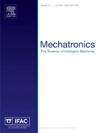A visco-elastic actuator with linear gas spring and variable damping
IF 3.1
3区 计算机科学
Q2 AUTOMATION & CONTROL SYSTEMS
引用次数: 0
Abstract
Series elastic actuators (SEAs) enhance safety and robustness in robotic joints but sacrifice torque and motion bandwidth compared to rigid actuators. Variable viscoelastic actuators (VVEAs) overcome these limitations by integrating an adjustable damping element with a spring, balancing open-loop torque bandwidth with impact safety and robustness. However, most existing VVEA designs rely on mechanical springs that add significant weight. We introduce a lightweight VVEA based on a pneumatic spring design. This actuator achieves linear, offline-adjustable stiffness using antagonistic gas chambers and provides online-adjustable damping via a hydraulic throttle valve. In our design, the increasing force of one chamber is moderated by the decreasing force of the other, resulting in a measured maximal deviation of 12% from the linear model. Additionally, an elastic silicone cast bladder replaces the conventional ring-shaped piston, significantly reducing breakaway force. To evaluate its benefits over standard actuators, we applied optimal control to periodic rest-to-rest motions typical of pick-and-place tasks. Based on mean tracking error, the VVEA outperforms SEAs in 29.1% of trials and rigid actuators in 89.2% of trials. Although increasing damping improves performance, it compromises safety; our optimization study demonstrates the potential of an online variable damping setpoint to balance these trade-offs. These results suggest that VVEAs hold great promise for applications requiring rapid maneuvers and enhanced impact safety and robustness.
一种线性气弹簧可变阻尼粘弹性作动器
系列弹性致动器(SEAs)提高了机器人关节的安全性和鲁棒性,但与刚性致动器相比,牺牲了扭矩和运动带宽。可变粘弹性致动器(VVEAs)通过将可调阻尼元件与弹簧集成在一起,平衡了开环扭矩带宽与冲击安全性和鲁棒性,从而克服了这些限制。然而,大多数现有的VVEA设计依赖于机械弹簧,这增加了很大的重量。介绍了一种基于气动弹簧设计的轻型VVEA。该执行器使用对抗式气室实现线性、离线可调刚度,并通过液压节流阀提供在线可调阻尼。在我们的设计中,一个腔室的增加力被另一个腔室的减少力所缓和,导致与线性模型的测量最大偏差为12%。此外,弹性硅树脂铸造气囊取代了传统的环形活塞,显著降低了分离力。为了评估其优于标准执行器的优点,我们将最优控制应用于典型的拾取和放置任务的周期性休息到休息运动。基于平均跟踪误差,VVEA在29.1%的试验中优于SEAs,在89.2%的试验中优于刚性致动器。虽然增加阻尼可以提高性能,但它会损害安全性;我们的优化研究证明了在线可变阻尼设定点平衡这些权衡的潜力。这些结果表明,VVEAs在需要快速机动和增强碰撞安全性和鲁棒性的应用中具有很大的前景。
本文章由计算机程序翻译,如有差异,请以英文原文为准。
求助全文
约1分钟内获得全文
求助全文
来源期刊

Mechatronics
工程技术-工程:电子与电气
CiteScore
5.90
自引率
9.10%
发文量
0
审稿时长
109 days
期刊介绍:
Mechatronics is the synergistic combination of precision mechanical engineering, electronic control and systems thinking in the design of products and manufacturing processes. It relates to the design of systems, devices and products aimed at achieving an optimal balance between basic mechanical structure and its overall control. The purpose of this journal is to provide rapid publication of topical papers featuring practical developments in mechatronics. It will cover a wide range of application areas including consumer product design, instrumentation, manufacturing methods, computer integration and process and device control, and will attract a readership from across the industrial and academic research spectrum. Particular importance will be attached to aspects of innovation in mechatronics design philosophy which illustrate the benefits obtainable by an a priori integration of functionality with embedded microprocessor control. A major item will be the design of machines, devices and systems possessing a degree of computer based intelligence. The journal seeks to publish research progress in this field with an emphasis on the applied rather than the theoretical. It will also serve the dual role of bringing greater recognition to this important area of engineering.
 求助内容:
求助内容: 应助结果提醒方式:
应助结果提醒方式:


